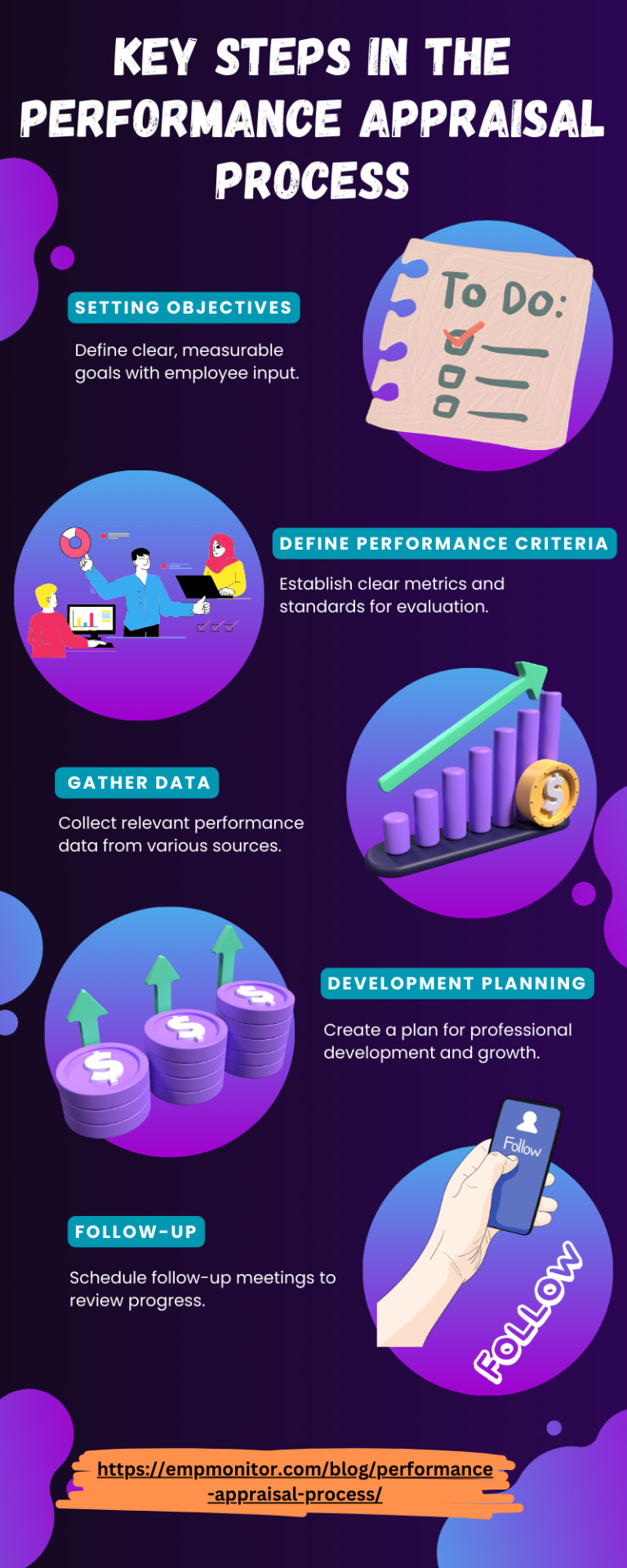#employee appraisal
Explore tagged Tumblr posts
Text
10 Ideas for Enhancing Your Performance Appraisal Process

In today’s fast-paced work environment, traditional performance appraisals often feel like a relic of the past—something to check off a list rather than a genuine opportunity for growth and connection. Employees want rapid, constructive, and engaging feedback, and businesses are increasingly recognizing the importance of nurturing talent to achieve success.
Consider a performance appraisal process that does more than just assess past performance; it actively promotes employee development, fires motivation, and deepens the link between managers and their teams.
In this blog, We will explore ten innovative ideas for enhancing your performance appraisal. These strategies aim to create a more meaningful dialogue, inspire professional growth, and ultimately contribute to a more engaged and productive workforce.
#1 Set Clear Expectations
Before the appraisal process begins, ensure that employees understand what is expected of them. Clear performance goals and criteria should be presented at the beginning of the review period. This transparency helps employees align their work with the company’s objectives, making the appraisal more relevant and constructive.
#2 Incorporate 360-Degree Feedback

360-degree feedback offers a more complete picture of an employee's performance. This strategy involves receiving feedback from a variety of sources, including peers, subordinates, and superiors. By collecting diverse perspectives, you can help employees gain a better understanding of their strengths and areas for improvement.
#3 Embrace Continuous Feedback
Move away from the annual review model and toward continual feedback. This approach encourages regular check-ins throughout the year, allowing managers and employees to discuss performance in real time. Frequent feedback can help address issues as they arise and foster a culture of open communication, reducing anxiety around formal appraisal meetings.
#4 Use Performance Management Software
Investing in performance management software can streamline the appraisal process. These tools often include features for setting goals, tracking progress, and facilitating feedback. With intuitive dashboards and analytics, both managers and employees can easily access performance data, making discussions more productive and focused.
#5 Focus on Employee Development

Shift the focus of appraisals from merely assessing past performance to emphasizing employee development. Appraisals can be used to identify growth areas and establish individualized development plans. Encouraging employees to pursue professional growth can boost engagement and retention rates.
#6 Make It a Two-Way Conversation
Encourage a two-way dialogue during the appraisal process. Instead of a one-sided review, create space for employees to express their thoughts, concerns, and aspirations. This collaborative approach not only builds trust but also allows managers to understand their employees' perspectives.
#7 Recognize and Reward Achievements
Incorporate recognition and rewards into your appraisal process. Recognizing an employee's accomplishments can increase morale and motivation. Consider implementing a structured reward system that aligns with performance monitoring outcomes, whether through bonuses, promotions, or public recognition.
#8 Utilize Goal-Setting Frameworks

Consider implementing goal-setting frameworks such as SMART (Specific, Measurable, Achievable, Relevant, Time-bound) or OKRs (Objectives and Key Results). These frameworks can provide clarity and direction, ensuring managers and employees are aligned on performance expectations.
#9 Offer Training for Managers
Train managers on effective appraisal techniques to ensure they provide constructive and actionable feedback. Training can cover active listening, delivering difficult messages, and setting SMART goals. Empowered managers are better equipped to support their teams through the appraisal process.
#10 Solicit Employee Feedback on the Process
Lastly, gather feedback from employees about the performance review process itself. Understanding their experiences and perspectives can provide valuable insights into what works and needs improvement. Use surveys or focus groups to collect input and be open to making adjustments based on their suggestions.
Also, watch this video - EmpMonitor | Leading Employee Engagement and Workforce Productivity Tool
youtube
Conclusion
Enhancing your performance appraisal system is essential for fostering a productive and engaged workforce. By implementing these ten ideas, you can create a more effective and supportive appraisal system that benefits employees and the organization. Remember, the goal of performance appraisals should not only be to assess performance but to inspire growth, development, and a culture of continuous improvement.
#performance appraisal#employee monitoring#appraisal system#360 degree appraisal#employee appraisal#Youtube
0 notes
Text
Performance appraisal is a process that assesses an individual employee's job performance and productivity in relation to certain pre-established criteria and organizational objectives.
#What is performance appraisal#performance appraisal#performance appraisal definition#performance appraisal meaning#types of performance appraisal#performance appraisal in HRM#employee appraisal
0 notes
Text

The Life Cycles of a Ranae Ebrius (Specifically Subject Epsilon aka Frogsilon)


Mat's got in undoubtedly bad (A crippling TBI courtesy of getting his head crushed by a Thumper + Lasso-Manification due to exposure to the Company Monster is not a great hand to be dealt), but at the very least he still has his sanity... The Lone Survivor on the other hand...

What the dog doin'?
#Eps Draws:#Lethal Company#Lethal Company OCs#Employee OC#Frogsilon#Mat the Inventory Appraiser#The Lone Survivor#Leon the Corpse Retriever#Eyeless Dog#Lasso Man
10 notes
·
View notes
Text
When I defend someone only for them to reveal they don't care whether I live or die

#lotta drama happening at work right now over an appraiser i dont even like#i always thought she was arrogant but at least smart and capable#but shes basically decided to openly jeapordize all of the other employees in part because shes salty that i am not just her assistant#and cannot drop everything at a moments notice to help her with stuff#hopefully she'll get her head screwed on straight after being locked out of the computers for a few days#happy eclipse everyone
2 notes
·
View notes
Text
How Do You Leverage Good Employee Appraisal System Services?

The presence of an employee performance management solution is an effective tool that can cater to the various services associated with core HR management functions with practical ease. This post deals with the category of employee appraisal services and its effective measures in the domain of efficient administration. Hop in to discover more regarding the exclusive tasks under an essential employee appraisal system with optimum delivery of services and solutions.
Factors Affecting Employee Appraisal System Solutions
The prominent management and support regarding the efficient and optimum management of employee appraisal programs or schemes should be considered to get the finest service solutions with a resource engagement platform or system. Some of the most important factors that can help your cause of employee appraisal are listed as follows:
Grade of efficiencyThe efficiency level and grade of the core HR operations can be actively demonstrated in an engaging and empowering HRMS platform. When you indulge in detailed employee records management, then this process becomes easier to execute and deploy with efficient and practical support in the general workflow.
Adaptability servicesThe features like adaptability, scalability, transparency, and integrity should be actively managed in a model or platform that showcases the likes and functions of the core employee support system with effortless ease.
Flexible integrationsYou can manage the various HR integrations and operations processes with the active support of streamlined and seamless integrations for getting the best services and solutions in the domain. An example is the satisfactory collaboration with a leave management system.
Platform initiativesThe performance appraisal platform should be capable of showcasing and portraying its set of unique initiatives and innovative or creative strategies for the betterment of the organization. It can be managed with the ideal support of core operations functions.
Creativity and innovationIn a credible and empowering employee system that works well with the effective management of innovative appraisal programs and systems, it is easy to manage the entire workflow of the core operations model without fail. You can get the optimum value-based solutions and services with this terrific model of activities.
When you go with a customized version of a core employee performance management solution to boost your HR operations, the ideal step is to optimize the process model with maximum efficiency upgrades and revisions. An employee appraisal system can get active value and benefits in this domain with an end-to-end solutions model or technology platform.
0 notes
Text
Key Steps in the Performance Appraisal Process
This infographic is a crucial resource for businesses and HR professionals seeking to enhance their performance appraisal process.

#performance appraisal process#performance appraisal#employee monitoring#performance appraisal system#360 degree performance appraisal
0 notes
Text
POV: Appraisal Meeting with Your Manager
#employee#manager#appraisal#creator#memes#meme#corporate#corporateworld#corporatememe#corporatememes#memesdaily#viralmemes#memeoftheday#swapnilkadam
0 notes
Text
Understanding the importance of performance appraisal is essential for business owners and managers. Learn how it can drive employee performance and organizational success
0 notes
Text
#The Future of Performance Reviews#performance management trends 2024#latest performance management trends#new performance management trends#employee performance management trends#performance management trend analysis#trends in performance management and feedback#current issues and trends in performance management#performance management current trends#changing trends in performance management#emerging trends in performance management#performance management future trends#global performance management process#hr trends performance management#top trends in performance management#key trends of performance management#latest trends in performance management system#performance management new trends#performance appraisal new trends#trends of performance management#2024 performance management trends#hrprocess#humanresourcemanagement#humanresource#hr#hrm#future of work
0 notes
Text
As the calendar turns and the year progresses, organizations worldwide gear up for a significant event in the corporate calendar - appraisal time. For managers, this period represents not only a time to assess individual performance but also an opportunity to strengthen the very foundation of their teams. In this article, we delve into the importance of appraisal time for managers, focusing on how they can leverage this period to foster team cohesion, motivation, and productivity.
1 note
·
View note
Text
#360-degree feedback#behaviourally anchored rating scales#being objective and fair#communication#comparative performance evaluation#critical incident technique#documentation#documenting everything#employee development#employee evaluation#encouraging self-assessment#feedback#focusing on behavior and results#focusing on growth and development#follow up#forced distribution#Goal setting#graphic rating scales#job performance#JobsBuster blog#management by objectives#mastering performance appraisal#narrative appraisals#organizational success.#performance appraisal#performance appraisal methods#performance review#preparing thoroughly#productivity#providing regular feedback
0 notes
Text
The Evolution of Performance Reviews: From Annual Appraisals to Continuous Feedback
A Look Back at Traditional Performance Reviews For decades, the annual performance review has been a cornerstone of corporate culture. Traditionally, this process involved a once-a-year meeting between an employee and their manager to discuss performance, set goals, and possibly discuss a salary increase or promotion. This method, rooted in the industrial age’s hierarchical and regimented work…

View On WordPress
#360-degree feedback#annual appraisals#bidirectional feedback#continuous feedback#Employee engagement#organizational culture#performance management technology#performance reviews#real-time feedback#workplace innovation
1 note
·
View note
Text
1 note
·
View note
Text
Enhancing Employee Performance through Effective Performance Appraisal
Introduction:
Performance appraisal plays a crucial role in maximizing employee productivity, engagement, and development within organizations. By implementing the right appraisal strategies, businesses can create a culture of continuous improvement, recognize achievements, and provide constructive feedback. This article explores the importance of performance appraisal, key elements of an effective appraisal process, and how Open HRMS offers transparent and engaging employee performance appraisal procedures.
Understanding Performance Appraisal:
Performance appraisal, also known as performance review or evaluation, is a systematic process that assesses an employee's job performance, skills, and achievements within a specific period. It provides a platform for employers and managers to communicate expectations, provide feedback, recognize accomplishments, and identify areas for improvement. Performance appraisals contribute to employee development, engagement, and overall organizational success.
Key Elements of an Effective Performance Appraisal:
To ensure a successful performance appraisal process, organizations should consider the following elements:
a. Clear Performance Goals and Expectations: Establishing clear and measurable performance goals is essential. Employees need to understand what is expected of them to align their efforts and focus on achieving those goals.
b. Regular Feedback and Communication: Timely and constructive feedback is critical for employee growth. Regular communication between managers and employees facilitates ongoing performance discussions, allowing for course corrections and acknowledging accomplishments.
c. Balanced Evaluation Criteria: Performance appraisal should consider a range of factors, including job-related skills, competencies, achievements, teamwork, and adherence to organizational values. A holistic evaluation provides a comprehensive view of an employee's performance.
d. Employee Self-Assessment: Encouraging employees to self-assess their performance fosters a sense of ownership and self-reflection. Self-assessment allows individuals to identify their strengths, areas for improvement and personal development goals.
e. Two-Way Communication: An effective performance appraisal is a dialogue rather than a monologue. Managers should actively listen to employees' perspectives, concerns, and aspirations, fostering a collaborative environment.
f. Performance Improvement Plans: In cases where performance falls below expectations, a performance improvement plan can be established. This plan outlines specific actions, timelines, and support mechanisms to help employees address performance gaps and reach their full potential.
Open HRMS: Transparent and Engaging Performance Appraisal Procedures:
Open HRMS provides a platform that streamlines the performance appraisal process, ensuring transparency and employee engagement. Key features of the Open HRMS performance appraisal module include
a. Top-Down and Bottom-Up Evaluation: Open HRMS allows organizations to design appraisal plans based on a top-down or bottom-up approach. This flexibility ensures that performance evaluations are aligned with the organization's strategic objectives while considering feedback from employees and peers.
b. Timely Feedback and Recognition: Open HRMS enables managers to provide timely feedback and recognition to employees for their achievements and contributions. This boosts morale, motivates employees, and reinforces positive behaviors.
c. 360-Degree Feedback: Open HRMS facilitates a comprehensive evaluation process by incorporating feedback from multiple sources, such as peers, subordinates, and customers. This holistic approach provides a well-rounded view of an employee's performance.
d. Performance Analytics and Reporting: Open HRMS offers performance analytics and reporting capabilities, allowing organizations to gain insights into individual and team performance. Data-driven reports enable informed decision-making, identifying trends, training needs, and performance gaps.
e. Employee Engagement: Open HRMS recognizes the importance of employee engagement during the appraisal process. By involving employees in goal-setting, self-assessment, and performance discussions, Open HRMS fosters a culture of continuous improvement and mutual growth.
0 notes
Text
Quality Features of Employee Appraisal System for You

The process of performance evaluation and appraisal management in an organization’s operations process cannot be understated. It is part of the employee engagement, performance management, and operational efficiency management model of an organization. This post explores the top-notch details and activity levels of an employee appraisal system in the organization. It should promote a genuine and well-crafted performance management process to boost the value of your organization’s operations model functions. You can also learn about the crucial significance of employee appraisal from the perspective of a professional HR team.
Primary Features of Employee Appraisal System
The top popular and common features that can add value to your employee management model or performance appraisal system are several. Check out a few of them below:
Enhanced performance processThe optimum responsibilities and duties associated with an empowering performance management process can be understood with the help and support of digital technology. The innovations under the feature category of employee records management matter in this specific case.
Competent expectationThe competency levels associated with the core expectation of an empowering HR management solution or system determine the capability of operations services in improving the performance appraisal program. It can be uniquely beneficial for your overall organizational process.
Clarification in the engagement modelThe provision of employee engagement can be satisfactorily managed with the support of core HR solutions in the performance and appraisal workflow systems or service solutions. You can get ultimate clarification for your core HR operations using the same.
Recognition and rewardsIt is impossible to create an HR payroll operations model by omitting the employee-oriented factor of recognition and rewards. It could be a boon to your resource engagement model. You can integrate the basic or default system with models like a leave management system for extensive integrations.
Rating scale and goal-setting approachThe promotion of ratings and reviews for an HR system and its wholesome approach to the adoption of new goals can act as a forerunner in the evaluation of operations functions and corresponding performance.
The customization techniques and performance strategies related to the application of employee appraisal management formulate a terrific workflow process. The core feature that can aid you in this model is the effective implementation of an employee appraisal system that is unique to the organization in question. It should also improve your credibility in the entire organization process.
0 notes
Text
Leveraging Technology for Business Growth: Transforming Performance Management for Success
Introduction:
In the fast-paced and competitive business environment of today, leveraging technology has become imperative for driving growth and maximising performance. One critical area where technology can make a significant impact is in performance management. By harnessing performance management systems, tools, and processes, businesses can optimise employee productivity, improve teamwork, and elevate overall performance. This blog delves into the transformative role of technology in performance management, ultimately leading to enhanced efficiency, heightened employee engagement, and sustained business success.
1. Performance Management Systems: Streamlining Performance Tracking and Evaluation
Performance management systems provide a structured framework for tracking and evaluating employee performance. These systems facilitate the establishment of performance goals, the monitoring of progress, and the execution of regular performance reviews. Through the utilisation of performance management software, businesses can automate these processes, resulting in greater efficiency and accuracy. Such systems empower managers and employees with real-time visibility into performance metrics, enabling data-driven decision-making and targeted performance improvement strategies.
2. Performance Planning: Aligning Goals and Objectives
Effective performance planning is paramount to achieving organisational goals. Technology serves as a facilitator by streamlining the performance planning process through tools for goal setting, cascading objectives, and progress tracking. Performance management software empowers managers to create and assign performance targets to individuals or teams, fostering alignment with the organisation's objectives. This bolsters clarity, focus, and accountability among employees, ultimately driving performance excellence.
3. Team Performance Management: Cultivating Collaboration and Productivity
Teams play a pivotal role in attaining business success. Technology offers an array of team management tools that facilitate seamless collaboration, efficient communication, and streamlined task allocation. Task management software empowers teams to organise, prioritise, and monitor their work, ensuring optimal task completion. This cultivates a culture of teamwork, enhances coordination, and augments overall productivity. Furthermore, virtual business tools enable geographically dispersed teams to collaborate seamlessly, fostering synergy in today's digital work environment.
4. Employee Performance Tracking and Analysis: Data-Driven Insights for Growth
Technology provides sophisticated tools for tracking and analysing employee performance. Employee time tracking apps and software enable businesses to monitor task durations, identify bottlenecks, and optimise resource allocation. These tools yield insights into employee productivity patterns and reveal areas for improvement. By leveraging employee performance data, businesses can implement targeted training programs, recognize high-performing employees, and make informed decisions to propel growth.
5. Attendance and Location Tracking: Streamlining Workforce Management
Efficient attendance and location tracking are integral to effective workforce management. Employee attendance tracker apps and software automate the attendance recording process, eradicating manual errors and simplifying payroll management. Moreover, employee location tracking tools allow businesses to monitor and map employee locations in real-time, ensuring safety, optimising resource allocation, and heightening operational efficiency.
6. Key Performance Indicator (KPI) Management: Measuring Success
Key Performance Indicators (KPIs) serve as pivotal metrics for measuring and monitoring performance. Technology equips businesses with KPI management tools that facilitate the definition, tracking, and analysis of performance against specific goals. These tools provide visually appealing representations of performance metrics, enhancing comprehension for managers and employees alike. Real-time updates offered by KPI trackers enable timely interventions and continual improvement efforts.
Conclusion:
In the digital age, harnessing technology for performance management is not merely a luxury but a necessity for business growth and success. By embracing performance management systems, leveraging performance tracking tools, embracing teamwork management solutions, and optimizing attendance tracking and KPI management tools, businesses can optimize employee performance, foster collaboration, and drive productivity. The power of technology lies in its ability to provide data-driven insights, streamline processes, and facilitate informed decision-making. By capitalizing on technology's potential, businesses can transform their performance management practices, unlock employee potential, and achieve sustainable growth in today's dynamic business landscape.
#work management#performances#daily task tracking#performance tracking#performance management#performance management system#performance management tools#team performance management#work management software#employee attendance app#attendance tracker app#task management software#task management apps#daily task tracker#human resource management system#task management#gps tracker#employee attendance#appraisal management#performance tracker app
1 note
·
View note